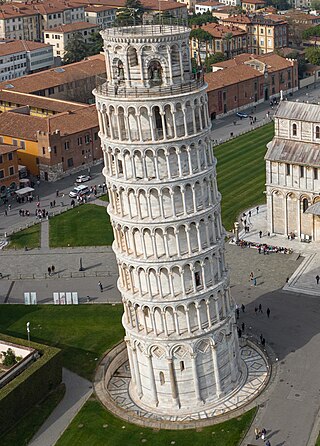
The Leaning Tower of Pisa, or simply the Tower of Pisa, is the campanile, or freestanding bell tower, of Pisa Cathedral. It is known for its nearly four-degree lean, the result of an unstable foundation. The tower is one of three structures in the Pisa's Cathedral Square, which includes the cathedral and Pisa Baptistry.

Perugia is the capital city of Umbria in central Italy, crossed by the River Tiber. The city is located about 164 km (102 mi) north of Rome and 148 km (92 mi) southeast of Florence. It covers a high hilltop and part of the valleys around the area.

St. Stephen's Cathedral is the mother church of the Roman Catholic Archdiocese of Vienna and the seat of the Archbishop of Vienna, Christoph Cardinal Schönborn, OP. The current Romanesque and Gothic form of the cathedral, seen today in the Stephansplatz, was largely initiated by Duke Rudolf IV (1339–1365) and stands on the ruins of two earlier churches, the first a parish church consecrated in 1147. The most important religious building in Vienna, St. Stephen's Cathedral has borne witness to many important events in Habsburg and Austrian history and has, with its multi-coloured tile roof, become one of the city's most recognizable symbols. It has 256 stairs from the top to the bottom

Tusks are elongated, continuously growing front teeth that protrude well beyond the mouth of certain mammal species. They are most commonly canine teeth, as with narwhals, chevrotains, musk deer, water deer, muntjac, pigs, peccaries, hippopotamuses and walruses, or, in the case of elephants, elongated incisors. Tusks share common features such as extra-oral position, growth pattern, composition and structure, and lack of contribution to ingestion. Tusks are thought to have adapted to the extra-oral environments, like dry or aquatic or arctic. In most tusked species both the males and the females have tusks although the males' are larger. Most mammals with tusks have a pair of them growing out from either side of the mouth. Tusks are generally curved and have a smooth, continuous surface. The male narwhal's straight single helical tusk, which usually grows out from the left of the mouth, is an exception to the typical features of tusks described above. Continuous growth of tusks is enabled by formative tissues in the apical openings of the roots of the teeth.

The ancient Romans were the first civilization to build large, permanent bridges. Early Roman bridges used techniques introduced by Etruscan immigrants, but the Romans improved those skills, developing and enhancing methods such as arches and keystones. There were three major types of Roman bridge: wooden, pontoon, and stone. Early Roman bridges were wooden, but by the 2nd century stone was being used. Stone bridges used the arch as their basic structure, and most used concrete, the first use of this material in bridge-building.

St Martin's Cathedral is a church in Bratislava, Slovakia, and the cathedral of the Archdiocese of Bratislava.

Arena AufSchalke, currently known as Veltins-Arena for sponsorship reasons, is a retractable roof football stadium in Gelsenkirchen, North Rhine-Westphalia, Germany. It opened on 13 August 2001, as the new home ground for FC Schalke 04.

Sensō-ji, is an ancient Buddhist temple located in Asakusa, Tokyo, Japan. It is Tokyo's oldest temple, and one of its most significant. Formerly associated with the Tendai sect of Buddhism, it became independent after World War II. It is dedicated to Kannon, the bodhisattva of compassion, and is the most widely visited religious site in the world with over 30 million visitors annually. Adjacent to the temple is a five-story pagoda, the Asakusa Shinto shrine, and many shops with traditional goods in the Nakamise-dōri.
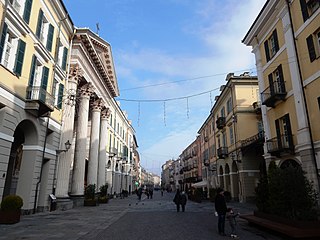
Cuneo is a city and comune in Piedmont, Italy, the capital of the province of Cuneo, the fourth largest of Italy’s provinces by area.
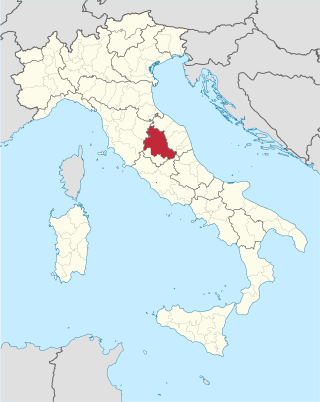
The province of Perugia is the larger of the two provinces in the Umbria region of Italy, comprising two-thirds of both the area and population of the region. Its capital is the city of Perugia. The province covered all of Umbria until 1927, when the province of Terni was carved out of its southern third. The province of Perugia has an area of 6,334 km2 covering two-thirds of Umbria, and a total population of about 660,000. There are 59 comuni in the province. The province has numerous tourist attractions, especially artistic and historical ones, and is home to the Lake Trasimeno, the largest lake of Central Italy. It is historically the ancestral origin of the Umbri, while later it was a Roman province and then part of the Papal States until the late 19th century.

A barbell is a piece of exercise equipment used in weight training, bodybuilding, weightlifting, powerlifting and strongman, consisting of a long bar, usually with weights attached at each end.

Iglesias is a comune and city in the province of South Sardinia, Italy. It was co-capital of the province of Carbonia-Iglesias with Carbonia, and the province's second-largest community.

The Cape York meteorite, also known as the Innaanganeq meteorite, is one of the largest known iron meteorites, classified as a medium octahedrite in chemical group IIIAB. In addition to many small fragments, at least eight large fragments with a total mass of 58 tonnes have been recovered, the largest weighing 31 tonnes. The meteorite is named after the location where the largest fragment was found: 23 miles (37 km) east of Cape York, in Savissivik, Meteorite Island, Greenland.

Casale Monferrato is a town in the Piedmont region of northwestern Italy, in the province of Alessandria. It is situated about 60 km (37 mi) east of Turin on the right bank of the Po, where the river runs at the foot of the Montferrat hills. Beyond the river lies the vast plain of the Po valley.

Roma Termini is the main railway station of Rome, Italy. It is named after the district of the same name, which in turn took its name from ancient Baths of Diocletian, which lies across the street from the main entrance. It is Italy's busiest railway station and the fifth-busiest in Europe, with a traffic volume of approximately 150 million passengers per year, and with 850 trains in transit per day.
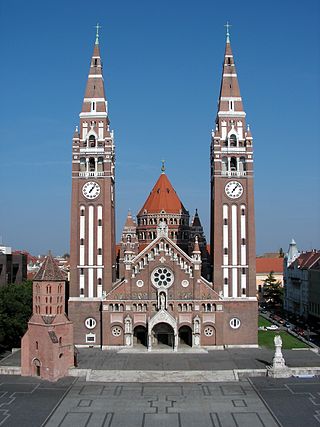
The Votive Church and Cathedral of Our Lady of Hungary is a twin-spired church in Szeged. It lies on Dóm square beside the Dömötör tower. Construction began in 1913, but due to the outbreak of the First World War, it was not completed until 1930. The church serves as the cathedral of the Roman Catholic Diocese of Szeged–Csanád.
A 16 ft Skiff is a class of three-person sailing dinghy with twin trapezes and a large asymmetrical spinnaker. The class is unique to Australia, where it is one of the most popular boats sailing with 95 boats registered in 12 clubs. The class has the largest fleet of high performance skiffs on the east coast of Australia. Due to the nature of only allowing two trapezes, the age of the sailors can vary between 15 and 60 years old, making it a versatile class of boat.
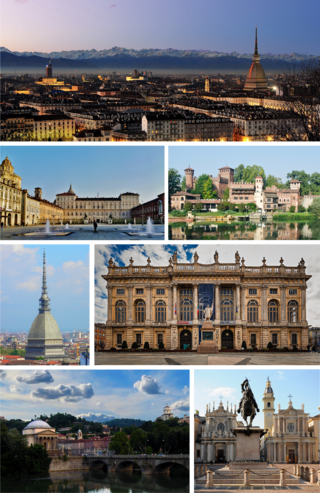
Turin is a city and an important business and cultural centre in Northern Italy. It is the capital city of Piedmont and of the Metropolitan City of Turin, and was the first Italian capital from 1861 to 1865. The city is mainly on the western bank of the Po River, below its Susa Valley, and is surrounded by the western Alpine arch and Superga hill. The population of the city proper is 843,514, while the population of the urban area is estimated by Eurostat to be 1.7 million inhabitants. The Turin metropolitan area is estimated by the OECD to have a population of 2.2 million.

Perugia railway station, also known as Perugia Fontivegge railway station is the main station serving the city and comune of Perugia, in the region of Umbria, central Italy. Opened in 1866, it forms part of the Foligno–Terontola railway, which also links Florence with Rome.
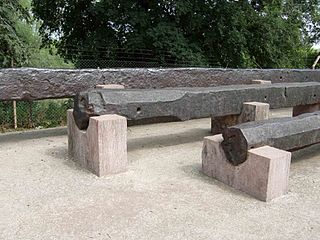
The Dhar iron pillar is a now-fragmented iron column located in the Dhar town of Madhya Pradesh, India. The exact origins of the pillar are unknown, but according to the local tradition, it was a victory column erected by the 11th century Paramara king Bhoja.




















